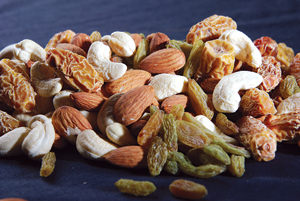W hether walking through a crowded bus park or in a small village, down the narrow lanes of Patan or in the bustling market at Ason, a snack is usually not far out of reach in Nepal, especially in Kathmandu. There are street vendors selling chatpata (a popular light snack), Indian sweet shops vending rich barfi and juice shops peddling fresh-squeezed drinks. But some of the most ubiquitous and most well-loved snacks in Nepal are dried fruits.

An assortment of Nepali dried fruits
Dried fruits can be found in large supermarkets, in tiny hole-in-the-wall shops and many places in between. Nepal is host to a number of unique fruits, both fresh and dried, that make for a delicious snack. Making, packaging and selling dried fruits has become a big business in Nepal, but it remains a traditional part of village life as well. Some companies based in Kathmandu produce dried fruits on a large scale, but it is also possible to see villagers in remote areas of the country drying sheets of pounded fruit to be sold and stored later in the season.
One of the most popular fruits in Nepal, whether fresh, dried or made into achar (pickle), is the lapsi. Light green in color and containing a fleshy part enveloping a large, hard seed, lapsi is similar to a mango except it is smaller in size. The sour fruit is made into a number of dried products, including sweet candy and spicy, beaten fruit strips. The sweet lapsi candy comes in a number of forms, including small rectangular strips or square cubes, which are light yellow in color and have a sweet, almost floral taste. For those without a sweet tooth, dried and spiced lapsi is another local favorite. The natural sourness of the lapsi fruit, mixed with the flavor of chili and spices, creates a distinctive and multilayered taste that is unique to dried fruits in Nepal.
A walk down the supermarket aisle or through the winding market lanes in Kathmandu reveals a number of choices for those hit with a craving for dried fruit. Plain dried apricots, mangos, amla (gooseberry) and figs, which will likely be familiar to a foreign visitor in Nepal, are widely available. But to get a true taste of the characteristically Nepali flavor of the snack, pick out one of the spiced varieties like the tukra piro, lamo chatpat or bechi titaura.
Titaura, which is sold in individual plastic packs or in bulk, is a pulp-like substance made from crushed and processed local fruits. The titaura pulp is sometimes dried, spiced and then cut into strips, but is also sold in moist as well as pulp forms. Titaura is flavored with a multitude of spices, including masala (spice) blends and chili powder.
The lanes that surround Ason Bazaar are some of the best places in Kathmandu to buy dried fruits in bulk. Many of the small ‘heritage’ shops that sell offerings for pujas (prayer rituals) also vend dried fruits, and several of the lanes between Ason Bazaar and Kathmandu Durbar Square are also packed with vendors selling dried fruits and nuts.











